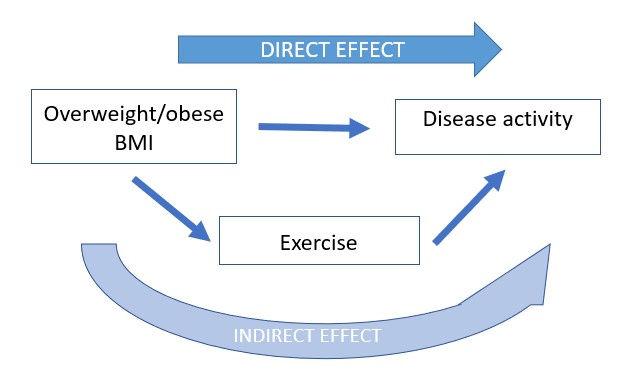Session Information
Date: Monday, November 9, 2020
Session Type: Poster Session D
Session Time: 9:00AM-11:00AM
Background/Purpose: Ankylosing spondylitis (AS) patients have elevated cardiovascular (CV) morbidity and mortality compared to general population comparators of the same age and sex. Although obesity is an important and modifiable CV risk factor, there are few prospective studies addressing the impact of higher body mass index (BMI) on clinical outcomes in AS. The aim of this study is to assess the relationship of BMI with disease activity in AS patients, and the extent to which the effect is mediated through exercise.
Methods: Data were available for 283 adults with AS meeting the 1984 modified New York criteria from a prospective cohort, who were followed at a single site at visits every 6 months with a median follow-up of 7 years. BMI (kg/m2) and disease activity as measured by the Ankylosing Spondylitis Disease Activity Score (ASDAS) represented the exposure and outcome, respectively. In the main analysis, we included 183 subjects who had at least one available BMI and one available ASDAS measure during any study visit; missing values were imputed using multiple imputation with chained equations. To determine the association of BMI and disease activity, we used generalized estimating equations to account for repeated measures per subject. We adjusted for age, sex, race, current smoking, nonsteroidal anti-inflammatory drug (NSAID) use, tumor necrosis factor inhibitor (TNFi) use, and follow-up time, and for interactions between BMI and sex and BMI and time. We then performed a causal mediation analysis to estimate the direct effect of BMI on disease activity, and the indirect effect through exercise.
Results: Among 183 subjects, 77% were male, 70% were white, and the mean±standard deviation age was 40.8±13.3 years. In adjusted analyses, higher BMI was significantly associated with higher disease activity over time; on average, for a 1 kg/m2 higher BMI, the ASDAS was 0.06 units higher (95% CI 0.02-0.09). This association did not differ by sex (p=0.89) but did differ over time (p=0.03). The direct effect of an overweight/obese BMI accounted for most of the total effect on disease activity, with a much smaller indirect effect mediated by exercise (9%).
Conclusion: Higher BMI was associated with higher disease activity in a prospective AS cohort. We found that being overweight/obese largely influences disease activity directly, rather than indirectly through exercise. This suggests that other mechanisms such as increased inflammation may better explain the obesity-disease activity association. Interventions targeting obesity may improve both disease activity and CV risk in this population.
 Directed acyclic graph demonstrating the direct effect of an overweight/obese BMI on disease activity, and the indirect effect of overweight/obese BMI on disease activity through exercise.
Directed acyclic graph demonstrating the direct effect of an overweight/obese BMI on disease activity, and the indirect effect of overweight/obese BMI on disease activity through exercise.
To cite this abstract in AMA style:
Liew J, Gianfrancesco M, Heckbert S, Gensler L. Exercise Partially Explains the Impact of Body Mass Index on Disease Activity in Ankylosing Spondylitis [abstract]. Arthritis Rheumatol. 2020; 72 (suppl 10). https://acrabstracts.org/abstract/exercise-partially-explains-the-impact-of-body-mass-index-on-disease-activity-in-ankylosing-spondylitis/. Accessed .« Back to ACR Convergence 2020
ACR Meeting Abstracts - https://acrabstracts.org/abstract/exercise-partially-explains-the-impact-of-body-mass-index-on-disease-activity-in-ankylosing-spondylitis/
